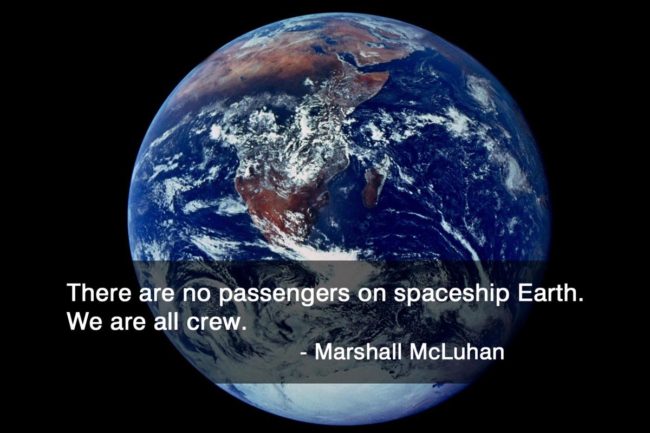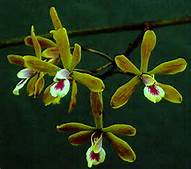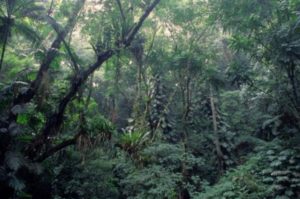
A Conservation “Moon Shot” – we are the ones piloting this ship
There is nothing more real and rewarding than the feeling you get when you walk into your greenhouse and experience that wonderful earthy fragrance, or when you notice the new flower spikes just forming on your Phalaenopsis that refused to bloom last year. It grounds you, it soothes your emotions, and you realize that the rest of the world we are bombarded with every day is just so much theater. It is all made up by fallible humans.
Your orchids are the result of millions of years of evolution in a symbiotic world of plants and animals from which we were all created. We are eukarotic brothers and sisters with our orchids sharing the same type of cell structure. And we both are fighting for survival in this Anthropocene period. We, our orchids, and 10 million other species on this planet, are all in the same boat.
When we read the day’s news it is easy to feel that we are losing ground in the battle for our own survival, and for the survival of species, including the orchids we love. Only recently I was saddened to learn that deforestation in the Amazon is on the rise again, after it appeared to be under better control. We know that a large number of species have already gone extinct, and we are aware that even species not yet discovered have disappeared before they could be documented and classified. It is easy to project, as some have, that eventually we will be left with nothing but humans living on our planet, with only monocultures and domesticated animals left to sustain us.

Biologist E.O. Wilson
But before we allow ourselves to sink into despair about such a bleak picture, we should note that there are experts in the field who bring a message of optimism. One very important person who sees a better answer, one we should listen to, is E. O. Wilson, considered to be one of the most influential biologists of our time. His most recent book “Half-Earth: Our Planet’s Fight for Life” has received much attention in the international conservation community. The title is based on an established principle of biological diversity, which he developed in the 1960’s, along with Robert MacArthur. Together they carried out studies on island biogeography where the environment was in equilibrium. This is what they found:
| Remove 50% of natural environment | 80% or more of species will survive and continue at a new sustainable condition. |
| Remove 90% of natural environment, such as experienced in the Atlantic Rainforest of Brazil, or in the Philippines | 50% of species will survive. |
I learned about this study from a Mongabay website interview with E.O.Wilson. Jeremy Hance, who conducted the interview, is an amazing free-lance science writer who reports on nature. In that interview (link below), Wilson explained what was so revolutionary about the half-earth theory:
I think what was not realized in the past was the application of that [50% removal] principle to conservation. And that from that principle, you could actually predict with lots of hope and lots of effort – you could actually predict saving the rest of life, the great majority of it, for an indefinite period of time in one stroke.
Wilson presents this “Half Earth” concept as a goal for the world of conservation which, he concludes, had not previously defined a target for success.
Goals and targets are critical for motivating action in people. Take, for example, our country’s history with the space program. When President John F. Kennedy spoke about U.S. goals for space exploration, he did not simply say that by the end of the 1960’s, the U.S. would simply make progress toward sending a man to the moon. Instead, in an address to Congress, he set a very clear, specific and measurable target. He said,
I believe that this nation should commit itself to achieving the goal, before this decade is out, of landing a man on the moon and returning him safely to the earth. No single space project in this period will be more impressive to mankind, or more important for the long-range exploration of space. -President Kennedy, Address to Congress on Urgent National Needs, May 25, 1961
This is exactly the kind of specificity and urgency recommended by E. O. Wilson. In Wilson’s words,
This goal of setting aside half of the earth for humans and half for the other species would give us something to shoot for like getting to the moon and back.
The big question is, having set such an ambitious goal, how can we implement it? Without having finished reading the book yet, I will go on Hance’s assessment that the book does not have all of the answers. Wilson is a scientist. He studies nature and explains how it works, and what we can expect if we continue on our present path. It is up to our world governments to formulate the required policy.
Just thinking about the natural areas remaining today, it is clear we do not have 50% of this planet set apart and protected. While the U.S. is far below that goal, some countries actually have more than 50% set aside already. Hance writes:
According to the World Bank, Venezuela and New Caledonia already had over half of their land in protected areas as of 2014. Bhutan had 47 percent; Zambia, Namibia, and Nicaragua 37 percent; Belize over 36 percent; and the Republic of the Congo 35 percent — and all of these are developing countries. In contrast, the U.S. has only protected 13.9 percent.
If we want to be regarded as world leaders, we certainly must do better.
 Simply setting aside additional land for more uninhabited nature parks is probably not feasible. But other possibilities exist. We could implement what are called “National Natural Area Designations”, a concept which has been already been successful in the U.S. For example, within some of our actual protected parks, areas have been set aside where people live sustainably with the land. Increasing the number of such arrangements would reverse the trends of multinational corporate destruction in places like Brazil. If more effort were made to respect the rights of indigenous people, these people could maintain their way of life while at the same time allowing nature to thrive. Indigenous people in almost every case, are the best protectors of land.
Simply setting aside additional land for more uninhabited nature parks is probably not feasible. But other possibilities exist. We could implement what are called “National Natural Area Designations”, a concept which has been already been successful in the U.S. For example, within some of our actual protected parks, areas have been set aside where people live sustainably with the land. Increasing the number of such arrangements would reverse the trends of multinational corporate destruction in places like Brazil. If more effort were made to respect the rights of indigenous people, these people could maintain their way of life while at the same time allowing nature to thrive. Indigenous people in almost every case, are the best protectors of land.
Other approaches could be like the example of the Flying D Ranch in Montana, where Ted Turner has designated his private property as a reserve. This ranch is thought to be the biggest in America, converted into one of the best prairie reserves in the world, with its native mega-fauna intact. People still use the land, but nature is respected and protected.
Wilson’s 50% plan would, in addition to existing parks, factor in reserves, private property and other forms of ownership. Where currently conservation efforts have focused on setting aside the most bio-diverse “hotspots” on the planet, Wilson’s plan would do more.

Encyclia patens orchid
found in Brazil
Even “re-wilding” is happening naturally in areas that are abandoned, and is most successful in forests that have been only harvested for timber but not totally cut down. Wilson talks about areas that were once rainforest, where the forests were subject to clear-cutting, with the land designated for agriculture. In most cases, the farms have been abandoned because they ceased to be productive within a few short years.
As we have learned over the years, rainforest soil is shallow and poor in nutrients. Without the constant replenishment that occurs in its natural state, the land which was formerly forest floor is not good for growing anything at all. But, given some time, the adjacent flora and fauna will expand out from existing forests and eventually reoccupy the area.

Tijuca rainforest, Brazil
One noted example: In the 1993 book “Orchids of Brazil”, authors Jim and Barbara McQueen recount that the guide books misidentify the Tijuca forest, a 120 square kilometer national park within the city of Rio. What is described as remnant forests (from the original Atlantic Rainforest) was actually cleared for growing coffee over a hundred years ago. The climate was unsuitable for growing coffee and the owner replanted many of the original tree species. Now Encyclia patens are reestablishing themselves naturally.
When we experience feelings of helplessness about current world affairs, a return to nature is where we can all find hope. Orchids have been my refuge from the high stress world of today. By studying orchids through my research, and by caring for my own orchids in my greenhouse, I am constantly reminded that nature has a great deal of resilience and adaptability built in. If we can manage to work alongside with nature, rather than exploit and abuse it, we can survive as a species and enjoy our beautiful Earth that is our home.![]()